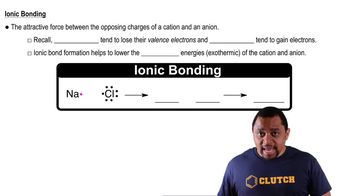Consider S, Cl, and K and their most common ions. (b) List the ions in order of increasing size. (c) Explain any differences in the orders of the atomic and ionic sizes.
Ch.7 - Periodic Properties of the Elements

Brown15th EditionChemistry: The Central ScienceISBN: 9780137542970Not the one you use?Change textbook
Chapter 7, Problem 36b
In the ionic compounds LiF, NaCl, KBr, and RbI, the measured cation–anion distances are 2.01 Å (Li–F), 2.82 Å (Na–Cl), 3.30 Å (K–Br), and 3.67 Å (Rb–I), respectively. b. Calculate the difference between the experimentally measured ion–ion distances and the ones predicted from Figure 7.8.
 Verified step by step guidance
Verified step by step guidance1
Identify the experimentally measured cation–anion distances for each ionic compound: LiF (2.01 Å), NaCl (2.82 Å), KBr (3.30 Å), and RbI (3.67 Å).
Refer to Figure 7.8 to find the predicted ion–ion distances for each of the ionic compounds based on the ionic radii of the cations and anions involved.
Subtract the predicted ion–ion distance from the experimentally measured distance for each compound to find the difference.
Express the differences in distances for each compound in Ångströms (Å).
Review the differences to understand any trends or discrepancies between the experimental and predicted values.

Verified video answer for a similar problem:
This video solution was recommended by our tutors as helpful for the problem above.
Video duration:
3mWas this helpful?
Key Concepts
Here are the essential concepts you must grasp in order to answer the question correctly.
Ionic Bonding
Ionic bonding occurs when atoms transfer electrons, resulting in the formation of charged ions. Cations (positively charged) and anions (negatively charged) attract each other due to electrostatic forces, creating ionic compounds. Understanding this concept is crucial for analyzing the properties and distances between ions in compounds like LiF, NaCl, KBr, and RbI.
Recommended video:
Guided course

Chemical Bonds
Cation-Anion Distances
Cation-anion distances refer to the measured distances between the centers of cations and anions in an ionic compound. These distances can be influenced by factors such as ionic size, charge, and the lattice structure of the compound. Analyzing these distances helps in understanding the stability and strength of ionic bonds in different compounds.
Recommended video:
Guided course

Cation Solubility
Experimental vs. Predicted Values
In chemistry, comparing experimental measurements with predicted values allows for the validation of theoretical models. In this context, the experimentally measured ion-ion distances can be compared to those predicted from established models or figures, such as Figure 7.8. This comparison helps identify discrepancies that may arise from factors like ionic radii or lattice energy.
Recommended video:
Guided course

Experimental Error
Related Practice
Textbook Question
Textbook Question
Arrange each of the following sets of atoms and ions in order of increasing size. Se2−,Te2−, Se
Textbook Question
True or false? c. S2− is larger than K+.
Textbook Question
In the ionic compounds LiF, NaCl, KBr, and RbI, the measured cation–anion distances are 2.01 Å (Li–F), 2.82 Å (Na–Cl), 3.30 Å (K–Br), and 3.67 Å (Rb–I), respectively. c. What estimates of the cation–anion distance would you obtain for these four compounds using neutral atom bonding atomic radii? Are these estimates as accurate as the estimates using ionic radii?
Textbook Question
Write the electron configurations for the following ions, and determine which have noble-gas configurations.
a. Ru3+
b. As3−
c. Y3+
d. Pd2+
e. Pb2+
f. Au3+
